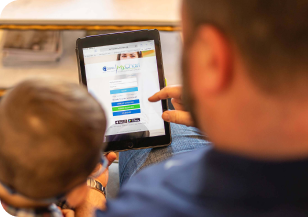GIVE NOW before 2025 ends—your gift will be doubled to help children in need. Click here to 2x your impact!

Ranked nationally in pediatric care.
Arkansas Children's provides right-sized care for your child. U.S. News & World Report has ranked Arkansas Children's in seven specialties for 2025-2026.

It's easier than ever to sign up for MyChart.
Sign up online to quickly and easily manage your child's medical information and connect with us whenever you need.

We're focused on improving child health through exceptional patient care, groundbreaking research, continuing education, and outreach and prevention.

When it comes to your child, every emergency is a big deal.
Our ERs are staffed 24/7 with doctors, nurses and staff who know kids best – all trained to deliver right-sized care for your child in a safe environment.

Arkansas Children's provides right-sized care for your child. U.S. News & World Report has ranked Arkansas Children's in seven specialties for 2025-2026.

Looking for resources for your family?
Find health tips, patient stories, and news you can use to champion children.

Support from the comfort of your home.
Our flu resources and education information help parents and families provide effective care at home.

Children are at the center of everything we do.
We are dedicated to caring for children, allowing us to uniquely shape the landscape of pediatric care in Arkansas.

Transforming discovery to care.
Our researchers are driven by their limitless curiosity to discover new and better ways to make these children better today and healthier tomorrow.

We're focused on improving child health through exceptional patient care, groundbreaking research, continuing education, and outreach and prevention.

Then we're looking for you! Work at a place where you can change lives...including your own.

When you give to Arkansas Children's, you help deliver on our promise of a better today and a healthier tomorrow for the children of Arkansas and beyond

Become a volunteer at Arkansas Children's.
The gift of time is one of the most precious gifts you can give. You can make a difference in the life of a sick child.

Join our Grassroots Organization
Support and participate in this advocacy effort on behalf of Arkansas’ youth and our organization.

Learn How We Transform Discovery to Care
Scientific discoveries lead us to new and better ways to care for children.

Learn How We Transform Discovery to Care
Scientific discoveries lead us to new and better ways to care for children.

Learn How We Transform Discovery to Care
Scientific discoveries lead us to new and better ways to care for children.

Learn How We Transform Discovery to Care
Scientific discoveries lead us to new and better ways to care for children.

Learn How We Transform Discovery to Care
Scientific discoveries lead us to new and better ways to care for children.

Learn How We Transform Discovery to Care
Scientific discoveries lead us to new and better ways to care for children.

When you give to Arkansas Children’s, you help deliver on our promise of a better today and a healthier tomorrow for the children of Arkansas and beyond.

Your volunteer efforts are very important to Arkansas Children's. Consider additional ways to help our patients and families.

Join one of our volunteer groups.
There are many ways to get involved to champion children statewide.

Make a positive impact on children through philanthropy.
The generosity of our supporters allows Arkansas Children's to deliver on our promise of making children better today and a healthier tomorrow.

Read and watch heart-warming, inspirational stories from the patients of Arkansas Children’s.

Hello.

Arkansas Children's Hospital
General Information 501-364-1100
Arkansas Children's Northwest
General Information 479-725-6800

 It's obvious by the way he greets and is welcomed by the nurses and staff - three-year-old Ace is comfortable at Arkansas Children's Northwest (ACNW). As he races through the hallways and climbs over furniture in one of the ACNW family rooms, his mother, Elizabeth Rivera, said his favorite things are "anything that involves speed" and anything that aggravates his younger sister. She describes him as more active and energetic than her other children at that age, but that wasn't always the case. "The child we have now, at 3 [years old], versus the one we had a year ago is night and day."
It's obvious by the way he greets and is welcomed by the nurses and staff - three-year-old Ace is comfortable at Arkansas Children's Northwest (ACNW). As he races through the hallways and climbs over furniture in one of the ACNW family rooms, his mother, Elizabeth Rivera, said his favorite things are "anything that involves speed" and anything that aggravates his younger sister. She describes him as more active and energetic than her other children at that age, but that wasn't always the case. "The child we have now, at 3 [years old], versus the one we had a year ago is night and day."
A Year Before – Night Terrors, Head Banging
The Riveras adopted Ace in 2021 when he was 13 months old. Ace was born prematurely and, at a little over a year old, hadn’t met several developmental milestones. Experienced foster parents, the Riveras had multiple adopted children, so some developmental delays and issues Ace was experiencing were familiar to them. Night terrors, or periods of crying and screaming in the night, are more common among adopted children, according to a study published by the National Institute of Health. Ace’s vocabulary and speech lagged behind his peers. And he had frequent head banging episodes.
Ace also had physical issues, like a jaw problem and a pronounced ridge on his skull. He came to Arkansas Children’s for genetic screening and physical examinations. One of his appointments was with Sagar Mehta, M.D., the director of the craniofacial team at Arkansas Children’s and an assistant professor of Surgery in the Division of Pediatric Plastic and Reconstructive Surgery at the University of Arkansas for Medical Sciences.
Based on the unusual shape of Ace's skull and the issues Rivera described, Mehta and the experienced team at Arkansas Children's Hospital in Little Rock immediately suspected craniosynostosis. A few measurements of his head confirmed the diagnosis as metopic craniosynostosis. A CT scan showed in more detail where Ace was experiencing pressure on his brain. Waking up crying multiple times a night was Ace's way of describing his pain.
"It's hard for a kid less than two or three years of age, and is non-verbal to say, 'Mom, there's pressure on my head.' They're not going to complain of headaches," Mehta said. "Kids may wake up crying, screaming, angry, irritable. Things like bottles may not console them because what they're having is a pretty significant headache."
What is craniosynostosis?
Rivera did what most parents do and turned to the internet to learn more about her child's condition. "It was a shock. I immediately tried to get as much information as I could."
Usually, when babies are born, their skull is made up of separate bones, or plates, that aren’t joined together. The spaces between the plates, called sutures, are made of tissue that hardens and becomes bone as the child gets older. The larger gaps between the plates are the typical “soft spots” on a baby’s head. The space between the plates allows the brain to expand and grow along with the rest of the body. Sometimes, the plates of the skull fuse too early, before the brain is done growing. When this happens, the skull can be misshapen. This condition, called craniosynostosis, occurs in about 1 in every 2,500 children born in the United States, according to the Centers for Disease Control and Prevention (CDC). Some cases are mild and can be corrected non-surgically. Some require surgery to relieve pressure on the brain – pressure that can lead to eye problems, seizures or brain damage.
Craniosynostosis looks different in every child, but there are five general types, depending on which of the skull plates has fused. Ace's type - metopic synostosis - is one of the rarest. Fortunately, the Arkansas Children's craniofacial team is one of the most experienced in the country.
Relief from Craniosynostosis
The treatments for craniosynostosis vary based on the child's age and which of the skull plates have fused. In children less than a few months old, a minimally-invasive surgery called an endoscopic strip craniectomy can often reshape the skull and give the brain room to grow. Even though he was only two years old, Ace's skull had already hardened too much. Based on the amount of pressure on Ace's brain, Mehta and the craniofacial team recommended a cranial vault reconstruction procedure.
Typically, the intricate surgery takes many hours and can involve blood transfusions and staying in a hospital's intensive care unit (ICU) for multiple days during recovery. The expert pediatric craniofacial specialists at Arkansas Children's have mastered techniques for increasing safe outcomes. Ace's surgery took over 9 hours, but safeguards allowed him to recover quickly.
"We were beyond surprised that we did not have a blood transfusion," Rivera said. "We were not admitted to the ICU and three days later were traveling back home." Ace's care team made him a special headwrap designed like the costume of one of his favorite comic book heroes to make looking back at pictures of surgery more fun for Ace and his family. "Every little thing was done with such detail and thought for Ace," his mom said.
One of the most significant moments in Ace’s recovery came two weeks later.
"My son had only said two words put together before the surgery...We'd even taught him some sign language because his speech just wasn't coming along. Two weeks after surgery, Ace looked at me and said, 'Mommy, whatcha doing?' I had never heard my son communicate articulately. To hear him in two weeks be able to say something he's been trying to get out for so long - that was one of the greatest reliefs."
One Year Later
Rivera said deciding to have major surgery on a young child was nerve-wracking, but she knows it was the right choice. "You would much rather have this as a planned procedure than an emergency surgery. My Arkansas Children's experience has been fantastic."
A year after the surgery, Rivera said the head banging has stopped, and Ace sleeps through the night. His vocabulary has grown so fast that he transitioned out of a daycare devoted to children with developmental delays and now mainstreams with his sister, whom he still loves to aggravate.

Meet our Craniofacial Team
More
Appointments
New and existing patients can visit our appointment hub for several ways to request an appointment, including online scheduling for many services.
Request an appointment
